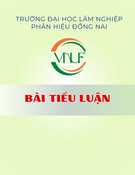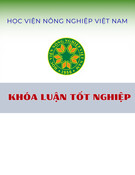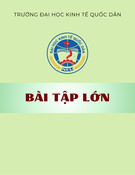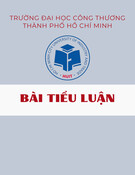
O. Reyes and M. CasalFire effects on cone opening Original article
Effect of high temperatures on cone opening
and on the release and viability of Pinus pinaster
and P. radiata seeds in NW Spain
Otilia Reyes*and Mercedes Casal
Área de Ecología, Dpto de Biología Fundamental, Fac de Biología, Univ de Santiago de Compostela,
15782 Santiago de Compostela, Spain
(Received 5 February 2001; accepted 29 August 2001)
Abstract –Pinus genus is characterized by woody cones able to open even after a forest fire, which also protect seeds from damages du-
ring the fire. The aim of the present study is to analyze the effect of high temperatures on pine cones opening as well as the releasing and
viability of the seeds of P. pinaster and P. radiata, throughout a selection of different combinations of temperatures and time exposures.
During a forest fire, extremely high temperatures have a very low remanence. 26 different combinations were selected, beginning by
500 ºC/1 min and then gradually increasing time exposure whereas the temperature, on the opposite, was set lower and lower. This pro-
cess was applied up to combinations of relatively low temperatures and long lapses of time such as 100 oC/30 min. 5 cones from each
species were tested with each combination, a total of 260 cones were finally set under study. P. pinaster species showed a scales’ opening
of 50% on average whereas P. radiata neared 90%. The rate for P. radiata seeds’ releasing is also higher than P. pinaster’s. Finally, the
viability of the seeds remained unchanged under the influence of thermal shocks for both Pinus species.
fire / high temperatures / pine cone opening / P. pinaster /P. radiata
Résumé – Effet des hautes températures sur l’ouverture des cônes, la dissémination et la viabilité des semences de P. pinaster et
P. radiata du NO d’Espagne. Le genre Pinus présente des cônes ligneux qui protègent les semences du feu et qui s’ouvrent même après
le feu. Le but de cette étude est de connaître l’effet des hautes températures sur l’ouverture des cônes, ainsi que sur la dissémination et la
viabilité des semences des espèces P. pinaster et de P. radiata au travers des différentes combinaisons de températures et temps d’expo-
sition. Lors d’un feu de forêt les très hautes températures ont un temps de remanence très peu élevé ; on a fait une sélection de 26 diffé-
rentes combinaisons de températures et temps d’exposition, à partir de 500 ºC/1 min et en augmentant progressivement le temps
d’exposition. L’on a fait décroître la température, jusqu’à des combinaisons de températures relativement basses avec de longs laps de
temps (100 ºC/30 min). Chacune de ces combinaisons de facteurs a été appliquée à 5 cônes de chaque espèce, un total de 260 cônes a été
étudié. L’espèce P. pinaster a présenté un taux moyen d’ouverture d’environ 50 % de ses écailles, alors que le P. radiata s’approche de
90 %. Le taux de semences disséminées est aussi plus élevé pour P. radiata que pour P. pinaster. Finalement, la viabilité des graines n’a
pas changé sous l’influence des chocs thermiques et ce, dans aucune des deux espèces de Pinus.
feu / hautes températures / ouverture des cônes / P. pinaster / P. radiata
Ann. For. Sci. 59 (2002) 327–334 327
© INRA, EDP Sciences, 2002
DOI: 10.1051/forest:2002028
* Correspondence and reprints
Tel. 34 981 563 100; Fax. 34 981 596 904; e-mail: bfreyes@usc.cs

1. INTRODUCTION
Some species in the genus Pinus are characterized by
an aerial seed bank [1, 5, 11, 15, 16, 31]. That is, seeds re-
main inside the cones on the parent tree for a long time
until conditions are suitable for dispersal and germina-
tion. In the event of fire, seeds already shed from the
cones may be burned and prove useless for reproduction.
Hence, the seeds most likely to survive are those that re-
main inside the cones and are dispersed after the fire, thus
avoiding destruction, or those that are buried in the soil.
Pinus seeds last for a very short time on the soil sur-
face as they are eaten or attacked by many different or-
ganisms [2, 12, 13, 18, 19, 22, 24, 26]. Therefore, soil
surface seed banks are quite ephemeral.
In contrast, seeds stored in cones form a seed bank that
is protected against predators. Likewise, in the event of a
forest fire, Pinus pinaster Aiton and Pinus radiata D.
Don cones protect their seeds. A few days after a fire,
cones slowly open their scales and release the seeds. Sur-
face fires do not usually affect the opening of pinecones
since the crowns are not sufficiently heated. However, in
crown fires flames can sometimes reach temperatures
close to 1000 ºC in a short space of time [9], which leads
to cone combustion. The role of fire in the opening of
cones and seed dispersal has been studied in some Pinus
species [4, 9, 10, 16–18, 24, 27, 32]. It is within this con-
text that we proposed to study the effect of a wide spec-
trum of temperature-heat residence time combinations
on the opening of P. pinaster and P. radiata cone scales,
on the release of seeds, and on their viability.
We chose P. pinaster and P. radiata from among all
the species of the genus Pinus because both are widely
used in reforestation, both frequently suffer crown fires
and demonstrate different degrees of serotiny: low in P.
pinaster and high in P. radiata.
2. MATERIALS AND METHODS
2.1. Experimental design
To carry out this experiment we selected mature and
apparently intact P. radiata and P. pinaster cones from
populations in Galicia (NW Spain). Ten cones were col-
lected from 13 individuals of each species, their colour
and position was not taken into account. A total of
260 pinecones were harvested and grouped into 26 lots of
5 cones from each species. Each treatment was applied to
5 replicates of one cone from each of the two species.
Given that the high temperatures produced during a
forest fire last for a relatively short time [8], we found
that when the closed cones were subjected to tempera-
tures or exposure times of over 500 ºC/1 min ignition oc-
curred. In order to cover the widest possible range, we
selected 26 different temperature-time combinations.
Starting at 500 ºC/1 min, we gradually increased expo-
sure times and reduced temperatures until relatively low
temperatures and long residence times were reached.
The following combinations of temperature-exposure were tested:
500 oC/0 min, 500 oC/1 min
400 oC/0 min, 400 oC/1 min
350 oC/0 min, 350 oC/1 min, 350 oC/5 min
300 oC/0 min, 300 oC/1 min, 300 oC/5 min, 300 oC/10 min
250 oC/0 min, 250 oC/1 min, 250 oC/5 min, 250 oC/10 min, 250 oC/15 min
200 oC/0 min, 200 oC/1 min, 200 oC/5 min, 200 oC/10 min, 200 oC/15 min, 200 oC/20 min
150 oC/0 min, 150 oC/5 min, 150 oC/10 min, 150 oC/15 min, 150 oC/20 min, 150 oC/25 min
100 oC/0 min, 100 oC/10 min, 100 oC/15 min, 100 oC/20 min, 100 oC/25 min, 100 oC/30 min
Once the selected oven temperature was stabilised,
five pinecones of each species were introduced. These
pinecones were removed after the specified exposure
time and the process was repeated for each treatment.
The number of open scales, dispersed seeds, and their
viability, was recorded for each cone subjected to ther-
mal shock.
328 O. Reyes and M. Casal

The percentage of open scales for P. pinaster and P.
radiata cones caused by induced heat was obtained by
counting all the open scales on each cone after the ther-
mal treatment had been applied. The scales were counted
manually and marked with a felt-tip pen to avoid confu-
sion. The value obtained refers to the maximum number
of scales capable of opening. To obtain this maximum
figure, the same cones were subjected to another thermal
shock, at 100 ºC for 2 hours, two days after the treatment
and the open scales were counted on the following day.
Prior to this, we tested different combinations of temper-
atures below 200 ºC and over prolonged periods and
checked that the P. pinaster and P. radiata cones that had
undergone 100 ºC for 2 hours had reached their maxi-
mum level of opening. This maximum level does not sig-
nify that all the scales open (the smallest and close to the
base never open). The total numbers of open scales were
counted after thermal shock and after subjection to
100 ºC over two hours. One value was expressed in rela-
tion to the other, thus obtaining a percentage of open
scales. The test for viability followed a commonly used
method, which consists of imbibing the seeds in 1%
tetrazole in darkness for 24 hours [23]. Live seed em-
bryos finally become reddish while those of dead seeds
do not change colour. This test was only applied to full
seeds. Empty seeds were counted and their percentage
was calculated.
2.2. Statistical processing
Data on the percentage of open scales and percentage
of dispersed seeds for both of the species was analysed
using two-way ANOVAs, to determine whether there
were any significant differences between the species and
the applied treatments. The Arcsin(Sqrt(x)) transforma-
tion was performed on the open scale and liberated seed
data. It was proved that significant interaction existed be-
tween the species and treatment factors. For this one-way
ANOVAs were performed, analysing the data of each
species separately. In those cases in which significant
differences were detected, a Tukey test was performed to
determine between which treatments these significant
differences existed.
3. RESULTS
Figure 1 shows the percentage of scales that opened in
P. pinaster, the seeds released, and their viability per-
centage. Figure 2 shows the values of the same three
variables for P. radiata. Given that the percentages of vi-
ability obtained in the treatments applied to both species
were nearly 100%, in figures 1 and 2we assumed that the
viability percentage of the seeds enclosed in the cones
before opening was 100%. Similarly, the percentage of
open scales and seeds dispersed in 0 time was 0.
3.1. Scale opening
The percentage of scales that opened as a result of
each of the thermal shocks tested is considerably differ-
ent when comparing P. pinaster and P. radiata. The for-
mer reveals a mean opening rate for scales of
approximately 52%, while almost 90% of P. radiata
scales opened. If the 200 ºC/1 min and 100 ºC/10 min
treatments for both species and the 150 ºC-5 min treat-
ment for P. pinaster are excluded, since they had no ef-
fect on the state of the scales, most of the opening rates
for P. pinaster were below 60% while the lowest value
obtained for P. radiata was 87.45 ± 4.87%.
Statistical analyses show large differences between P.
pinaster and P. radiata and in the interaction between
species and treatments this was highly significant
(table I). For these two reasons we opted for the study of
Fire effects on cone opening 329
Table I. Results obtained by applying two-way ANOVA to the values of scale opening data.
Source Sum of Squares df Mean square F-Ratio P-Value
MAIN EFFECTS
A : species
B : treatments
INTERACTIONS
AB
RESIDUAL
69189.2
63505.5
424544.8
157918.0
1
25
25
208
69189.2
2540.22
1698.19
759.219
91.13
3.35
2.24
0.0001
0.0001
0.0011
TOTAL (CORRECTED) 333067.0 259

each species separately. No marked differences were
found between treatments in P. pinaster, but this was not
so in the case of P. radiata (F= 60.68, df = 25, p=
0.0001). Differences in the latter were due to the
200 ºC/1 min and 100 ºC/10 min treatments in which the
percentage of open scales was 0.0%.
On analysing the results of the thermal treatments for
each species individually, we found that the increase in
exposure time at a given temperature had no cumulative
effect on the percentage of open scales. In P. pinaster
(figure 1), the variations in the percentage of scales that
opened at a given temperature, with increasing exposure
times, were erratic. In contrast, in P. radiata with a rela-
tively short exposure time, a threshold percentage
(87.45%) of scale openings is obtained and remains more
or less constant, even when exposure time is increased
(figure 2).
330 O. Reyes and M. Casal
Figure 1. Percentage of open scales, released seeds and seed viability for P. pinaster. The variation of each percentage is shown in rela-
tion to exposure time for each of the selected temperatures.

3.2. Seed release
Following the above pattern, the percentage of seed
release is also greater in P. radiata than in P. pinaster.
The latter released 11.91% of the seeds that could poten-
tially have been released in view of the number of open
scales. Two seeds could be released per scale. The mean
dispersal rate for P. radiata was 50.41 ± 1.78% and
reaches 54.61 ± 1.34% if the two cases in which no cones
opened and hence no seeds were released (200 ºC/1 min
and 100 ºC/10 min) are excluded.
In each of the tested temperatures, variation in expo-
sure time is not linked to a gradual increase in the rate of
seed release (figures 1 and 2), or in the rate of scale open-
ing. In both P. pinaster (figure 1) and P. radiata (fig-
ure 2), the rates of seed release are invariably lower than
the rate of scale opening, but follow the same pattern.
Fire effects on cone opening 331
Figure 2. Percentage of open scales, released seeds and seed viability for P. radiata. The variation of each percentage is shown in rela-
tion to exposure time for each of the selected temperatures.

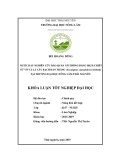
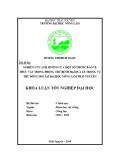
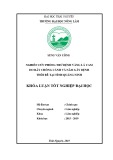
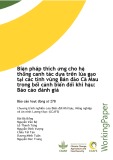
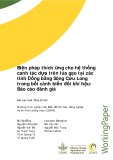
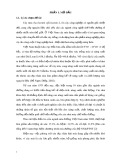
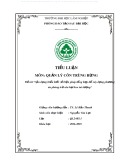
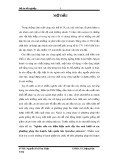
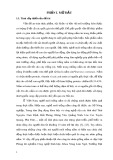
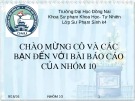

![Bệnh Leptospirosis: Khóa luận tốt nghiệp [Nghiên cứu mới nhất]](https://cdn.tailieu.vn/images/document/thumbnail/2025/20250827/fansubet/135x160/63991756280412.jpg)
